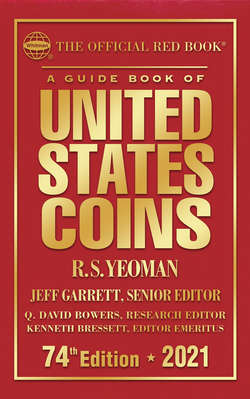Читать книгу A Guide Book of United States Coins 2021 - R.S. Yeoman - Страница 24
На сайте Литреса книга снята с продажи.
Other Popular First-Year Coins
ОглавлениеAmong other United States coins struck since 1792, these first-year-of-issue varieties (a partial list) were saved in large numbers and are especially plentiful today:
• 1943 zinc-coated steel cent. The novel appearance of this coin resulted in many being saved as curiosities.
• 1883 Liberty Head nickel without CENTS. The Mint expressed the value of this new design simply as “V,” without mention of cents—not particularly unusual, as three-cent pieces of the era were simply denominated as “III.” Certain people gold-plated the new nickels and passed them off as five-dollar gold coins of similar diameter. Soon, the Mint added CENTS. News accounts were printed that the “mistake” coins without CENTS would be recalled and would become very rare. So many were saved that today this variety is the most plentiful in Mint State of any Liberty Head nickel in the entire series from 1883 to 1913.
• 1913 Buffalo nickel. These were saved in large quantities. Today more Mint State coins of this year exist than for any other issue of the next 15 years.
• 1837 Liberty Seated, No Stars, half dime. Several thousand or more were saved, a large number for a half dime of the era. Apparently, their cameo-like appearance made them attractive curiosities at the time, as was also true of dimes in 1837.
• 1837 Liberty Seated, No Stars, dime. Somewhat over a thousand were saved, a large number for a dime of the era.
• 1916 “Mercury” dime. Quantities were saved of the 1916 and 1916-S, the first year of issue. However, for some reason the low-mintage 1916-D was generally overlooked and today is very rare in Mint State.
• 1932 Washington quarter. At the Philadelphia Mint, 5,504,000 were minted, and it is likely that several hundred thousand were saved, making them plentiful today. The 1932-D quarter was struck to the extent of 436,800, but for some reason was overlooked by the public, with the result that Mint State coins are rare today. On the other hand, of the 408,000 1932-S quarters struck, thousands were saved. Today, Mint State 1932-S quarters are at least 10 to 20 times more readily available than are equivalent examples of the higher-mintage 1932-D.
• 1999–2008 State quarters. From 1999 to 2008, five different quarter dollar designs were produced each year, with motifs observing the states in the order that they joined the Union. These coins were highly publicized and collected.
• 1964 Kennedy half dollar. The popularity of the assassinated president was such that although hundreds of millions were minted, it is likely that many were saved as souvenirs both at home and abroad. This was also the last year of the 90% silver-content half dollar made for circulation, further increasing its popularity.
• 2000 Sacagawea “golden dollar.” These coins, intended to be a popular, wear-resistant substitute for paper dollars, were launched with much fanfare in 2000, and many were saved by the public. However, the coin did not catch on for general use in commerce. Later issues have been made for sale to collectors, not for circulation.
• MCMVII (1907) High-Relief gold twenty-dollar coin. Although only about 12,000 were minted, at least 6,000 survive today, mostly in Mint State. Released in December 1907, the coin, by famous sculptor Augustus Saint-Gaudens, created a sensation, and soon the coins were selling for $30 each. Today, Mint State coins are plentiful, but as the demand for them is extremely strong, choice specimens sell for strong prices. An MS-63 coin lists for $24,000.
• 1892 and 1893 World’s Columbian Exposition commemorative half dollars. These, the first U.S. commemorative half dollars, were widely publicized, and hundreds of thousands were saved. Today they are very common in used condition.
